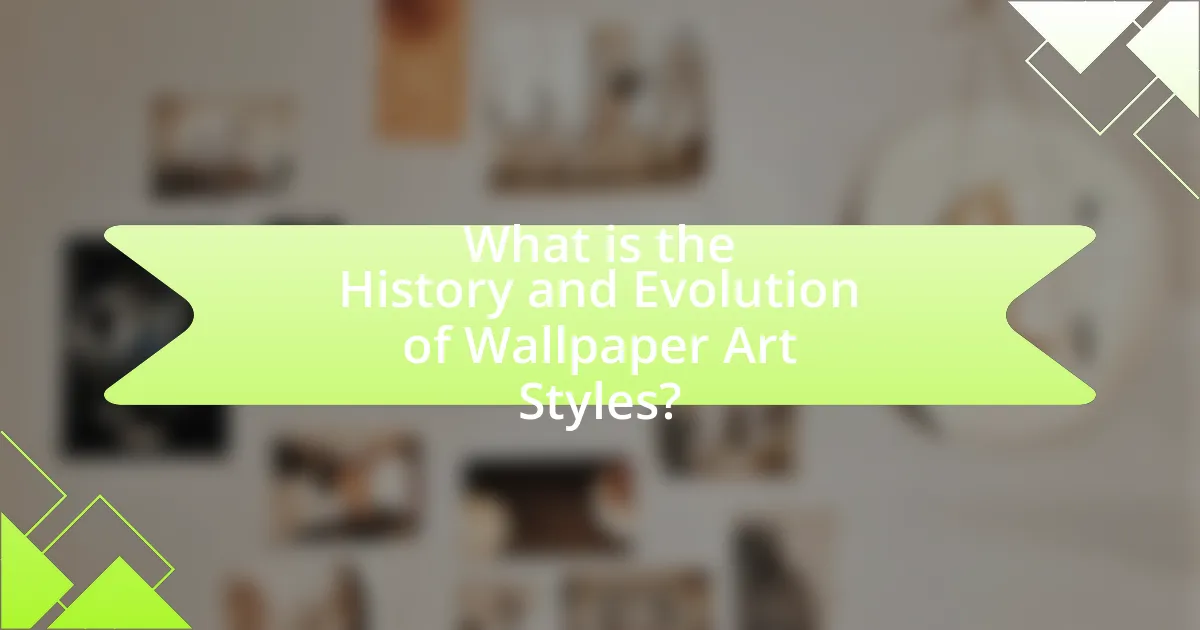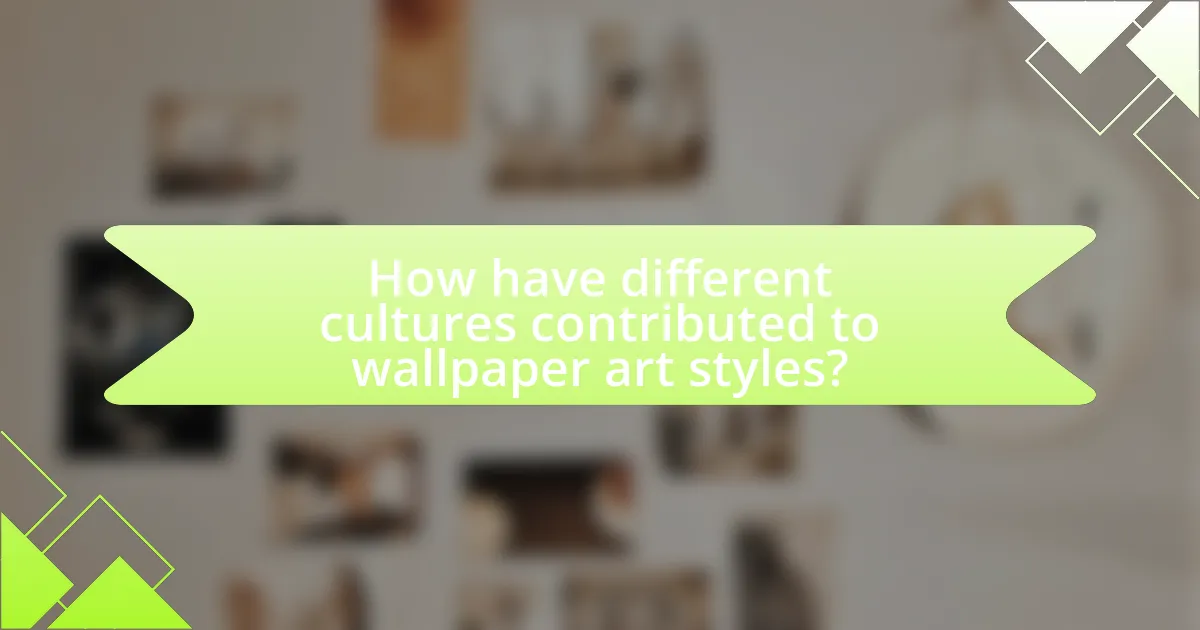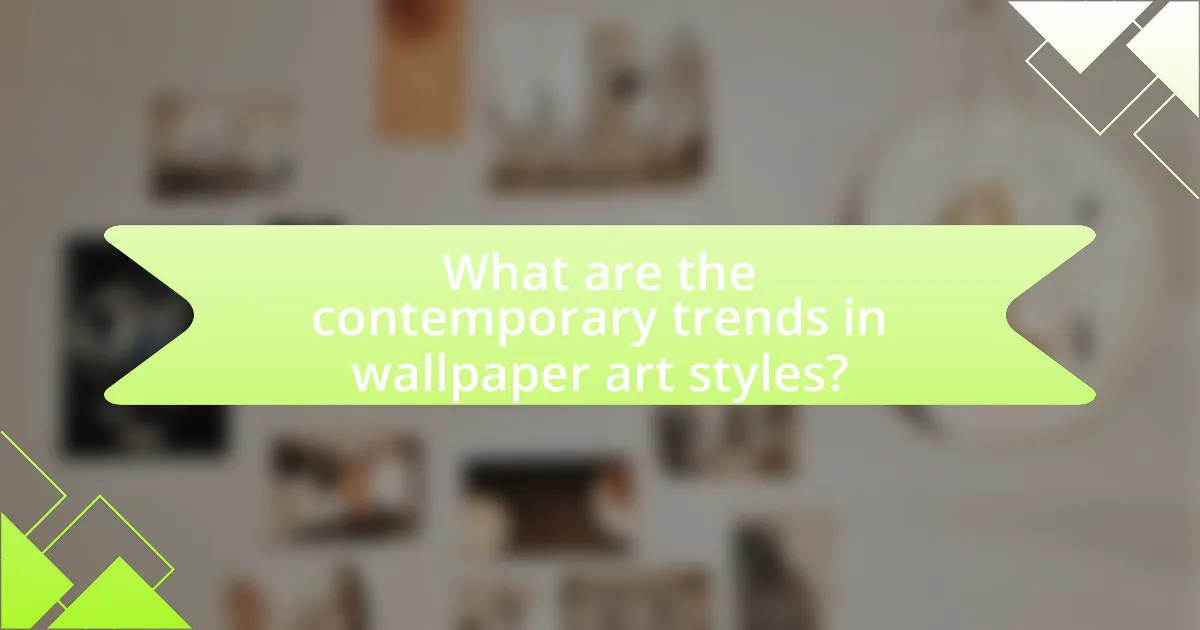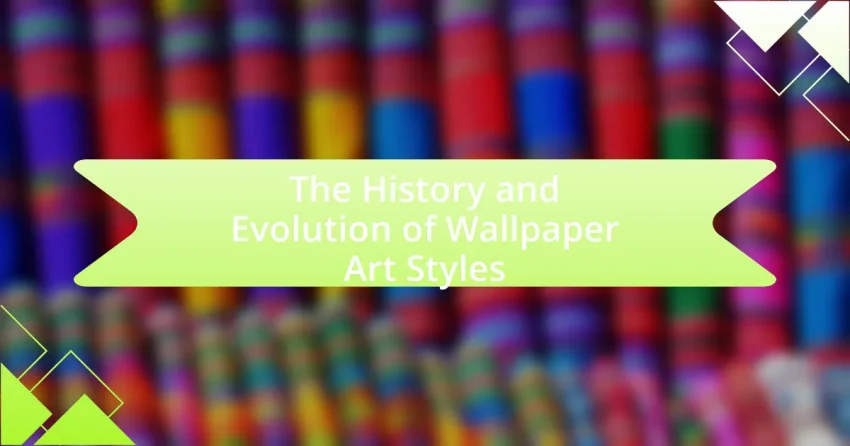The article explores the history and evolution of wallpaper art styles, tracing its origins back to ancient China around 200 B.C. and its spread to Europe in the 16th century. It highlights key developments in wallpaper production, including advancements in printing technology during the Renaissance and the Industrial Revolution, which facilitated mass production and diverse designs. The influence of various historical periods, such as Baroque, Rococo, and modern movements like Art Nouveau and Art Deco, is examined, showcasing how cultural exchanges and technological innovations have shaped wallpaper aesthetics over time. Additionally, contemporary trends, including the use of sustainable materials and digital printing, are discussed, reflecting current consumer preferences and design innovations.

What is the History and Evolution of Wallpaper Art Styles?
The history and evolution of wallpaper art styles began in ancient China, where the earliest forms of wallpaper were created using rice paper and hand-painted designs around 200 B.C. This practice spread to Europe in the 16th century, where wallpaper became a popular alternative to costly tapestries. By the 18th century, advancements in printing technology, such as block printing and later, the introduction of wallpaper machines, allowed for mass production and intricate designs, including floral patterns and scenic landscapes. The Victorian era saw a surge in decorative styles, with bold colors and elaborate motifs becoming prevalent. In the 20th century, modernism introduced minimalist designs, while postmodernism embraced eclectic styles, leading to a diverse range of wallpaper art that continues to evolve today. The transition from hand-painted to machine-printed wallpaper reflects technological advancements and changing aesthetic preferences throughout history.
How did wallpaper art styles originate?
Wallpaper art styles originated in China during the Han Dynasty (206 BC – 220 AD), where decorative paper was used to adorn walls. This practice spread to Europe in the 16th century, primarily through trade routes, leading to the development of various styles influenced by cultural and artistic movements. For instance, the introduction of block printing in the 17th century allowed for intricate designs, while the Industrial Revolution in the 19th century further transformed wallpaper production with mechanization, enabling mass production and diverse patterns. The evolution of wallpaper art styles reflects historical shifts in technology, culture, and aesthetics, establishing it as a significant decorative art form.
What were the earliest forms of wallpaper?
The earliest forms of wallpaper were hand-painted or block-printed papers used in China during the Han Dynasty (206 BCE – 220 CE). These early wallpapers served decorative and functional purposes, often featuring intricate designs and motifs. Historical records indicate that by the 16th century, wallpaper began to spread to Europe, where it was used to cover walls in homes and palaces, evolving from simple patterns to more elaborate designs.
How did cultural influences shape early wallpaper designs?
Cultural influences significantly shaped early wallpaper designs by integrating motifs, patterns, and techniques from various artistic traditions. For instance, the introduction of Chinese silk wallpapers in Europe during the 17th century brought intricate designs and vibrant colors, which inspired local artisans to adopt similar aesthetics in their own creations. Additionally, the Rococo style, prevalent in France, emphasized ornate and playful designs that reflected the cultural values of the time, leading to the development of wallpapers that featured floral patterns and pastoral scenes. The incorporation of these diverse cultural elements not only enriched the visual appeal of wallpapers but also mirrored the social and economic exchanges occurring globally, particularly through trade routes.
What major historical periods influenced wallpaper art styles?
The major historical periods that influenced wallpaper art styles include the Renaissance, Baroque, Rococo, Neoclassicism, and the Arts and Crafts Movement. The Renaissance, spanning the 14th to 17th centuries, introduced intricate designs and classical themes, while the Baroque period (17th century) emphasized grandeur and opulence in patterns. The Rococo style, emerging in the early 18th century, favored lightness and ornate motifs, contrasting with the more structured Neoclassicism of the late 18th century, which drew inspiration from ancient Greece and Rome. Finally, the Arts and Crafts Movement in the late 19th century reacted against industrialization, promoting handcrafted designs and natural themes. Each of these periods significantly shaped the aesthetic and thematic evolution of wallpaper art.
How did the Renaissance impact wallpaper design?
The Renaissance significantly influenced wallpaper design by introducing intricate patterns and a focus on naturalism. During this period, artists began to explore perspective, proportion, and realistic representations of nature, which translated into wallpaper designs featuring elaborate motifs, landscapes, and classical themes. The invention of the printing press in the 15th century also allowed for the mass production of wallpaper, making these artistic designs more accessible to the public. This shift marked a departure from the simpler, more utilitarian wall coverings of the medieval period, establishing wallpaper as a medium for artistic expression and decoration in homes.
What role did the Industrial Revolution play in wallpaper production?
The Industrial Revolution significantly transformed wallpaper production by introducing mechanization and mass production techniques. This period, spanning from the late 18th to the early 19th century, enabled manufacturers to produce wallpaper more efficiently and at a lower cost. Innovations such as the steam-powered printing press allowed for the rapid printing of intricate designs, which previously required labor-intensive handcrafting. By the mid-19th century, wallpaper became widely accessible to the middle class, with factories producing large quantities of patterned papers, reflecting the era’s artistic styles and trends. The shift from artisanal to industrial methods marked a pivotal change in the wallpaper industry, leading to a diverse range of designs and increased availability for consumers.
What are the key developments in wallpaper art styles over time?
Key developments in wallpaper art styles over time include the transition from hand-painted designs in ancient China to the introduction of printed wallpapers in Europe during the 18th century. Initially, wallpapers featured intricate hand-painted motifs, often depicting nature and landscapes, which were labor-intensive and costly. The invention of block printing and later, rotary screen printing, revolutionized wallpaper production, making it more accessible and affordable. By the 19th century, the Arts and Crafts movement emphasized handcrafted designs, while the Art Deco period introduced bold geometric patterns and vibrant colors. The mid-20th century saw the rise of modernist styles, characterized by minimalism and abstract designs. Each of these developments reflects broader artistic trends and technological advancements, shaping the evolution of wallpaper art.
How did the introduction of new materials change wallpaper design?
The introduction of new materials significantly transformed wallpaper design by enabling more intricate patterns, textures, and durability. For instance, the advent of vinyl in the mid-20th century allowed for washable and more resilient wallpapers, which expanded design possibilities and made them suitable for various environments. Additionally, advancements in printing technology, such as digital printing, facilitated the creation of custom designs and vibrant colors, further enhancing aesthetic appeal. These innovations not only improved functionality but also allowed designers to experiment with styles, leading to a diverse range of wallpaper options that cater to different tastes and interior design trends.
What innovations in printing techniques affected wallpaper styles?
Innovations in printing techniques that affected wallpaper styles include the introduction of block printing, lithography, and digital printing. Block printing, developed in the 15th century, allowed for the mass production of intricate designs, significantly influencing wallpaper patterns and accessibility. Lithography, introduced in the late 18th century, enabled the reproduction of detailed images and colors, leading to more vibrant and complex wallpaper designs. Digital printing, emerging in the late 20th century, revolutionized wallpaper production by allowing for custom designs and rapid printing, catering to individual tastes and modern aesthetics. These advancements collectively transformed wallpaper from a luxury item into a widely available decorative element, reflecting changing artistic trends and consumer preferences.

How have different cultures contributed to wallpaper art styles?
Different cultures have significantly influenced wallpaper art styles through their unique artistic traditions and motifs. For instance, Chinese wallpaper often features intricate landscapes and floral designs, reflecting the importance of nature in Chinese culture, while the use of bold colors and geometric patterns in African textiles has inspired contemporary wallpaper designs that celebrate cultural heritage. Additionally, European styles, such as the Rococo and Art Nouveau movements, introduced ornate and flowing designs that emphasized elegance and craftsmanship. Historical evidence shows that the introduction of block printing in Europe during the 15th century allowed for the mass production of wallpaper, further blending various cultural influences into a cohesive art form.
What are the unique characteristics of Asian wallpaper art?
Asian wallpaper art is characterized by intricate designs, vibrant colors, and cultural symbolism. The use of natural motifs, such as flora and fauna, reflects the region’s deep connection to nature and spirituality. Traditional techniques, including hand-painted and block-printed methods, emphasize craftsmanship and detail, often resulting in unique, one-of-a-kind pieces. Historical influences, such as Chinese and Japanese aesthetics, contribute to the diversity of styles, with elements like calligraphy and landscape scenes being prevalent. The integration of these characteristics showcases the rich cultural heritage and artistic traditions of Asia, making Asian wallpaper art distinct in the global context.
How did traditional Chinese wallpaper influence Western designs?
Traditional Chinese wallpaper significantly influenced Western designs by introducing intricate patterns, vibrant colors, and themes inspired by nature and mythology. During the 17th and 18th centuries, European trade with China led to the importation of Chinese wallpapers, which featured elaborate scenes of landscapes, flora, and fauna. This exposure prompted Western designers to adopt similar motifs and techniques, resulting in the creation of chinoiserie, a style that emulated Chinese aesthetics. The popularity of these designs in Europe is evidenced by the production of hand-painted wallpapers in France and England, which sought to replicate the exotic appeal of their Chinese counterparts.
What motifs are commonly found in Japanese wallpaper art?
Common motifs found in Japanese wallpaper art include nature scenes, floral patterns, and traditional symbols such as cranes and cherry blossoms. These motifs reflect the deep connection between Japanese culture and nature, often emphasizing seasonal changes and harmony. For instance, cherry blossoms symbolize the transient beauty of life, while cranes represent longevity and good fortune. Historical examples, such as the Edo period’s ukiyo-e prints, showcase these motifs, illustrating their significance in Japanese aesthetics and cultural identity.
How has European wallpaper evolved through various artistic movements?
European wallpaper has evolved significantly through various artistic movements, reflecting changes in design, technology, and cultural influences. Initially, in the Renaissance period, wallpaper featured intricate hand-painted designs, often depicting classical themes and nature, which aligned with the broader artistic trends of the time. The Baroque movement introduced more elaborate patterns and rich colors, emphasizing opulence and grandeur, as seen in the works of artists like Jean-Baptiste Huet.
During the Rococo period, wallpaper designs became lighter and more playful, incorporating pastel colors and whimsical motifs, which mirrored the shift towards a more intimate and decorative style in interior design. The Industrial Revolution brought about mass production techniques, allowing for the widespread availability of printed wallpapers, which led to the emergence of bold patterns and motifs in the Victorian era, characterized by floral designs and intricate damasks.
In the 20th century, movements such as Art Nouveau and Bauhaus influenced wallpaper design, with Art Nouveau introducing organic forms and flowing lines, while Bauhaus emphasized simplicity and functionality. The post-war period saw a revival of bold colors and geometric patterns, reflecting the modernist aesthetic. Today, contemporary wallpaper continues to evolve, incorporating digital printing technologies and sustainable materials, showcasing a blend of historical influences and modern innovation.
What impact did Baroque and Rococo styles have on wallpaper design?
Baroque and Rococo styles significantly influenced wallpaper design by introducing elaborate patterns, rich colors, and intricate motifs. The Baroque period, characterized by grandeur and drama, led to wallpapers featuring bold designs, often depicting historical or mythological scenes, which were intended to create a sense of opulence in interiors. Rococo, emerging later, emphasized elegance and lightness, resulting in wallpapers adorned with delicate floral patterns, asymmetrical designs, and pastel colors, reflecting a more playful and ornate aesthetic. These styles collectively transformed wallpaper from simple wall coverings into integral elements of interior decoration, showcasing artistry and craftsmanship that defined the decorative arts of the 17th and 18th centuries.
How did Art Nouveau and Art Deco redefine wallpaper aesthetics?
Art Nouveau and Art Deco significantly redefined wallpaper aesthetics by introducing organic forms and geometric patterns, respectively. Art Nouveau, emerging in the late 19th century, emphasized flowing lines, natural motifs, and intricate designs inspired by nature, which transformed wallpaper into a medium for artistic expression. This style often featured floral and plant themes, as seen in the works of artists like Alphonse Mucha, who utilized soft colors and elaborate patterns to create immersive environments.
In contrast, Art Deco, which gained prominence in the 1920s and 1930s, brought a bold, streamlined aesthetic characterized by geometric shapes, symmetry, and vibrant colors. This movement reflected the modernity and luxury of the era, with wallpapers often showcasing stylized motifs and metallic finishes, as exemplified by the designs of Jean Dunand and other prominent decorators. Together, these movements shifted wallpaper from mere functional decor to a significant element of interior design, influencing the overall ambiance of spaces.

What are the contemporary trends in wallpaper art styles?
Contemporary trends in wallpaper art styles include bold patterns, sustainable materials, and digital printing techniques. Bold patterns, such as oversized florals and geometric designs, are increasingly popular as they create striking visual statements in interior spaces. Sustainable materials, including recycled paper and eco-friendly inks, reflect a growing consumer preference for environmentally responsible choices in home decor. Additionally, advancements in digital printing technology allow for customization and intricate designs that were previously difficult to achieve, enabling consumers to personalize their spaces more than ever. These trends are supported by market research indicating a significant rise in demand for unique and sustainable home decor options, highlighting the evolving landscape of wallpaper art styles.
How are modern technologies influencing wallpaper design today?
Modern technologies are significantly influencing wallpaper design today by enabling advanced printing techniques, customization options, and the integration of smart technology. Digital printing allows for high-resolution images and intricate patterns that were previously difficult to achieve, resulting in more vibrant and detailed designs. Additionally, technologies such as 3D printing and augmented reality are facilitating personalized wallpaper solutions, allowing consumers to visualize and customize their choices in real-time. The incorporation of smart technology, such as wallpapers that can change color or pattern through app control, reflects a shift towards interactive and dynamic interior design. These advancements demonstrate a clear evolution in wallpaper design, driven by technological innovation.
What role does digital printing play in current wallpaper trends?
Digital printing significantly influences current wallpaper trends by enabling customization and rapid production. This technology allows designers to create intricate patterns and vibrant colors that were previously difficult or impossible to achieve with traditional printing methods. For instance, digital printing facilitates the use of high-resolution images and personalized designs, catering to individual consumer preferences. According to a report by Smithers Pira, the digital wallpaper market is expected to grow at a compound annual growth rate of 20% from 2020 to 2025, highlighting the increasing demand for unique and customizable wallpaper solutions.
How are sustainable materials being integrated into wallpaper production?
Sustainable materials are being integrated into wallpaper production through the use of eco-friendly substrates, inks, and adhesives. Manufacturers are increasingly opting for materials such as recycled paper, organic cotton, and bamboo, which reduce environmental impact. For instance, the use of water-based inks instead of solvent-based ones minimizes harmful emissions during production. Additionally, companies are adopting biodegradable adhesives to enhance the sustainability of their products. This shift is supported by a growing consumer demand for environmentally responsible options, as evidenced by a report from the Sustainable Furnishings Council, which highlights that 70% of consumers prefer products made from sustainable materials.
What are the popular themes and patterns in today’s wallpaper styles?
Popular themes and patterns in today’s wallpaper styles include botanical designs, geometric shapes, and textured finishes. Botanical designs often feature large-scale floral prints and tropical motifs, reflecting a trend towards nature-inspired aesthetics. Geometric patterns, characterized by bold lines and shapes, provide a modern and minimalist appeal, often used in contemporary interiors. Textured finishes, such as linen or metallic effects, add depth and sophistication to spaces. According to a 2023 report by the Wallpaper Manufacturers Association, these themes have gained significant traction, with botanical designs increasing in popularity by 25% over the past year, indicating a strong consumer preference for natural elements in home decor.
How do contemporary designers draw inspiration from historical styles?
Contemporary designers draw inspiration from historical styles by analyzing and reinterpreting design elements, patterns, and techniques from past eras. For instance, the use of intricate floral motifs in modern wallpaper can be traced back to the Rococo period, where similar designs were prevalent. Designers often study historical documents, art movements, and cultural contexts to understand the significance of these styles, allowing them to incorporate traditional aesthetics into contemporary applications. This practice not only honors the craftsmanship of the past but also revitalizes it, making it relevant for today’s consumers.
What are the current color trends in wallpaper design?
Current color trends in wallpaper design include earthy tones, muted pastels, and bold jewel colors. Earthy tones such as terracotta, olive green, and warm beige create a natural and calming atmosphere, reflecting a growing preference for sustainability and organic aesthetics. Muted pastels like soft pinks, light blues, and gentle yellows offer a serene and sophisticated look, appealing to minimalist design sensibilities. Bold jewel colors, including deep emerald, sapphire, and ruby, are gaining popularity for their dramatic impact and ability to create focal points in a room. These trends are supported by market research indicating a shift towards colors that evoke comfort and connection to nature, aligning with contemporary interior design preferences.
What practical tips can help in selecting wallpaper art styles for your space?
To select wallpaper art styles for your space effectively, consider the overall theme and color palette of the room. Matching the wallpaper style to existing decor ensures cohesion; for instance, a modern space may benefit from geometric patterns, while a traditional room might suit floral designs. Additionally, assess the scale of the room; larger patterns can overwhelm small spaces, whereas subtle designs can enhance them. According to a study by the American Society of Interior Designers, 70% of designers recommend considering natural light, as it influences how colors and patterns appear throughout the day. Therefore, testing samples in different lighting conditions can help in making an informed choice.
How do you choose the right wallpaper for different rooms?
To choose the right wallpaper for different rooms, consider the room’s purpose, size, lighting, and existing decor. For example, in a living room, opt for warm colors or patterns that create a welcoming atmosphere, while in a bedroom, softer tones or calming designs promote relaxation. In smaller spaces, lighter colors can make the area feel larger, whereas bold patterns can add character to larger rooms. Additionally, consider the amount of natural light; brighter wallpapers can enhance light in dim rooms, while darker shades can create a cozy feel in well-lit areas. These choices are supported by design principles that emphasize color psychology and spatial perception, ensuring that the wallpaper complements the room’s function and aesthetic.
What factors should be considered when mixing wallpaper styles?
When mixing wallpaper styles, consider color harmony, pattern scale, and thematic consistency. Color harmony ensures that the colors of different wallpapers complement each other, creating a cohesive look. For example, using a bold floral pattern alongside a subtle geometric design can work if both share a common color palette. Pattern scale refers to the size of the designs; mixing large patterns with smaller ones can create visual interest, but they should be balanced to avoid overwhelming the space. Thematic consistency involves ensuring that the styles convey a similar mood or concept, such as combining vintage styles with other retro designs to maintain a unified aesthetic. These factors are essential for achieving a well-coordinated and visually appealing interior.
